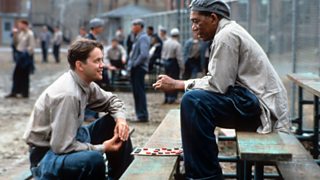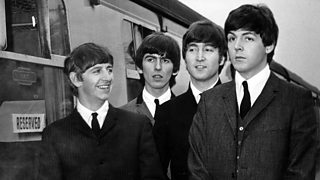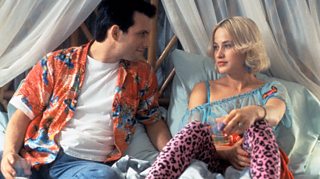Seven of the most memorable vampires in film and TV
Vampires have been part of cinema almost since its earliest days. From the many takes on Bram Stoker's Dracula, to the knowing teen drama of Buffy the Vampire Slayer, to the swooning romance of Interview With the Vampire, bloodsuckers have functioned as a metaphor for youthful lust, disease, loneliness and many more things besides. Vampires may have begun in horror, but they've made their way into just about every genre, even children's animation (see: Hotel Transylvania).
Hosts of 大象传媒 Radio 4's Screenshot Ellen E Jones and Mark Kermode are sinking their teeth into the rich history of vampires on screen, talking to experts about the merits of everything from Nosferatu to Twilight. Here are seven screen vampires so good they'll likely live forever.
Dracula – Dracula
You have to include Dracula, obviously. Bram Stoker’s creation has loomed over cinema for decades, in many different guises, but two are definitive. Horror movie expert Kim Newman explains that the classic Dracula image actually comes from a 1920s stage adaption of the book. “There are all kinds of things about vampires that come from that play,” he says. “The whole reason we think of Dracula as wearing a cloak is because the play is set in a drawing room, so Dracula is in evening dress.”

That look carried on to Bela Lugosi’s iconic, pristinely turned-out Dracula in 1931. He set the screen template of Dracula as suave, seductive and regal. The 1958 Hammer Dracula imitated the look and upped the overt sexuality with Christopher Lee’s swaggering take. “He’s sexy and dynamic, and that’s what Hammer makes Dracula into… A Sadean figure, but also a bodice-ripping romance figure.” We’ve seen that pushed in many directions since, from Francis Ford Coppola’s grandly camp 1992 take, to the comically absurd in 2023’s Renfield. Dracula will likely live on in movies for centuries.
Count Orlock – Nosferatu
Arguably second in influence only to the Bela Lugosi Dracula, FW Murnau’s 1922 silent film was the first proper vampire movie. Broadly based on Dracula, it has Max Schreck as vampire Count Orlock, who’s consumed by the need to drink the blood of a beautiful young woman (Greta Schröder).
Orlock’s far from the seductive image that defined later vampires – his rodent teeth and unblinking stare are distinctly unsexy – but his shadowy presence and stillness have inspired many horror interpretations since. And here we already see the mood of grand romance that’s core to the vampire myth. “He dies for love,” says Kim Newman. Orlock perishes sitting at the young woman’s bed as the sun rises. “Everybody forgets that he dies for a romantic reason.”
David – The Lost Boys
We single out their leader, David (Keifer Sutherland), but you could include all the gang in Joel Schumacher’s 1987 movie. It follows a new guy (Jason Patric) in a small town, who falls in with a gang of hard-partying vampires.
“Becoming a vampire actually seems sexy and cool,” says Mike Muncer, presenter of the Evolution Of Horror podcast. “The Lost Boys really solidified that link between vampirism and teen culture.” It also began the idea of vampires as pin-ups and free-living outsiders. “When you’re a teenager and figuring out who you are, maybe exploring your identity and sexuality, vampire mythology gives you free reign to explore,” says Muncer. “In Lost Boys, Michael is kind of drawn to these boys. There are always interesting queer readings of vampire stories.”
Lestat – Interview With the Vampire
“Interview With the Vampire introduces the innovation that vampires can have different characters,” says Kim Newman. “In almost all previous vampire stories, the vampires are the same person: they’re all Dracula.” Anne Rice’s books, and Neil Jordan’s 1994 film, created a world of vampires with contrasting personalities.

Tom Cruise’s Lestat has the arrogance of Dracula, but he’s also needy and lonely. Brad Pitt’s Louis is a soft-hearted soul who hates how he’s forced to ‘live’. The story leans hard into the idea of vampires as swooning romantics and doomed beauties. “Anne Rice’s vampires [are] tormented, fashionable and gothic,” continues Kim Newman. “Anne Rice informs so many of the vampire figures of the 80s and 90s… Spike and Angel and Drusilla (from Buffy The Vampire Slayer) are very Anne Rice coded.”
Watch the TV adaptation of Interview With the Vampire on 大象传媒 iPlayer now
Spike – Buffy the Vampire Slayer
There are many good vampire characters in Joss Whedon’s 1990s TV show, but the best of them is Spike (James Marsters). Starting out as a pure villain, Spike grows into something close to a good guy, learning how to love and move beyond his most basic emotions. He embodies what the show is about, the turmoil of youth.
“Buffy took the teen experience, whether it’s getting bullied, getting your first boyfriend, losing your virginity – all those issues were dealt with in really interesting, metaphorical ways,” says Mike Muncer. In Buffy, the vampire is the eternal teenager.
Eli – Let the Right One In
Tomas Alfredson’s 2008 masterpiece one-ups the teen movies by making its vampire a child, the haunting Eli (Lina Leandersson). It’s a play on the limitations of the vampire life.
Eli, unable to go out in the day or pass as an adult, needs someone to care for her and supply her victims, so she befriends a young boy (Kåre Hedebrant) who might replace her ageing assistant. “The strength of Let the Right One In is it comes up with a different and complicated relationship between vampire and minion,” says Kim Newman.
Edward – Twilight
Mark has never made any apologies for his affection for the much-mocked YA 2000s vampire film franchise. What Buffy did with its tongue in its cheek, Twilight did more sincerely. “It’s a metaphor for sexual abstinence,” says Kim Newman. Edward (Robert Pattinson) is the youthful, handsome vampire who desperately wants to feed on Bella (Kristen Stewart) but has to resist because he loves her so much.
Here, there’s no horror to vampirism. It’s romantic melodrama on a Romeo and Juliet scale. It demonstrates that vampires can work for any audience. The series was huge in a way no vampire horror ever has been. “From this point onwards, no longer are vampires relegated to the shadows and the gothic,” says Mike Muncer. “They’ve now become fully mainstream.”
Here more about Ellen and Mark's investigations into the fanged undead by listening to the episode in full on 大象传媒 Sounds.
More articles from Screenshot
-
![]()
Eight of the greatest prison movies and TV shows
Breaking down the best depictions of prison across film and TV.
-
![]()
Eight of the most memorable pop star portrayals on screen
Pop idol stories that struck a chord with us in film and on TV.
-
![]()
Seven of cinema's most memorable outlaw couples
On the trail of the law-breaking lovers who lit up our screens.
-
![]()
Nine of the most impressive stunts in movie history
Celebrating the unsung art of the Hollywood stuntperson.





